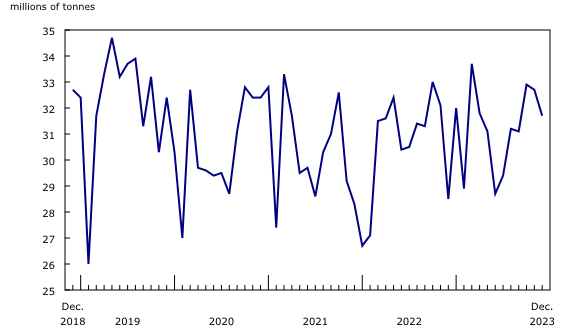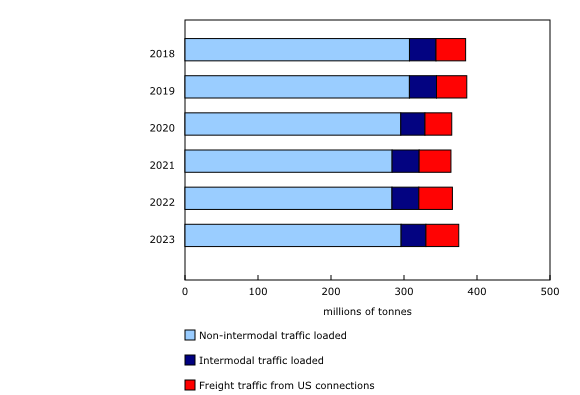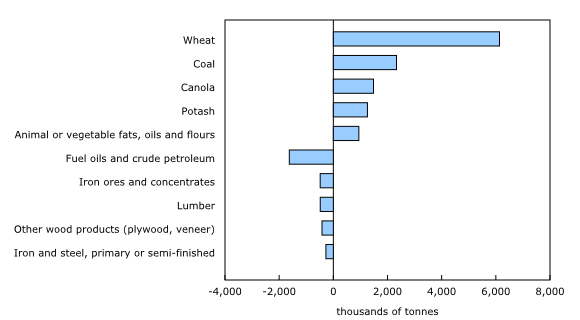Railway carloadings, December 2023
Released: 2024-02-22
31.7 million metric tonnes
December 2023
11.2% 
(12-month change)
Highlights
Canadian railways transported 31.7 million tonnes of freight in December, up 11.2% from December 2022. This was the second straight month of year-over-year growth and the largest increase in tonnage since January 2023.
Non-intermodal freight loadings in Canada increased 10.2% from the same month in 2022, to reach 25.4 million tonnes in December. Higher shipments of potash, iron ores and some energy products more than offset a continued decline in some agricultural and food products, notably grain.
Intermodal freight loadings in Canada (mainly containers) increased 9.4% year over year to 2.8 million tonnes in December. This marked the first increase since November 2022, following 12 straight months of year-over-year decreases.
Finally, loadings from American railways have increased year over year for five straight months, up 21.0% to 3.5 million tonnes in December.
To further explore current and historical data in an interactive format, please visit the "Monthly Railway Carloadings: Interactive Dashboard."
The year in review, 2023
The total annual rail freight carried in Canada during 2023 was 375.1 million tonnes, up 2.4% from 2022 levels, with most gains in tonnage generated in the early part of the year.
During the first few months of 2023, rail freight volumes were consistently above 2022 totals with growth driven by considerable increases in carloadings of agricultural and food products, notably grains, in large part due to delivery and export of a bumper harvest across the Prairies during 2022. For example, loadings of wheat increased by an average of 1.2 million tonnes year over year each month from January to April of 2023.
From May 2023 onward, total freight carried by Canadian railways began to lag 2022 levels and, through October, overall tonnage was below the same months in 2022, caused by a confluence of factors: disruptions to railways and port operations caused by wildfires in June 2023 and the labour dispute in July at Canada's west coast ports.
Despite these disruptions and lower crop yields on the Prairies during 2023, freight traffic was higher in the last two months of the year, helping to push total cargo volume moved by Canadian railways to 375.1 million tonnes for the year—approaching the pre-COVID-19 pandemic levels from 2018 and 2019.
Compared with 2022, non-intermodal freight loadings in Canada increased 4.4% to 296.0 million tonnes in 2023, while intermodal freight traffic was down 7.6% to 34.0 million tonnes—the lowest annual level since 2020. Finally, freight traffic coming from the US rail connections saw an annual decline for the first time since 2020, dipping 2.2% from 2022 to 45.0 million tonnes in 2023.
Key commodity shift in 2023
During 2023, growth in non-intermodal freight traffic (mainly commodities) was driven by considerable tonnage increases in some agricultural and food products—especially grain during the early part of the year. Leading the way was wheat, with loadings of 26.5 million tonnes, up 30.2% (or +6.1 million tonnes) from 2022 levels—the largest annual increase ever recorded.
Similarly, loadings of canola increased 22.1%, from 6.7 million tonnes in 2022 to 8.2 million tonnes in 2023, while potash was up 5.5%, reaching 24.3 million tonnes.
Other large increases were reported for coal, with loadings up 6.2% from 2022 to 39.7 million tonnes in 2023.
The declines from 2022 to 2023 were more moderate and widespread among commodities. Of note however, loadings of fuel oils and crude petroleum decreased for the fourth consecutive year, down sharply (-13.4%) to 10.5 million tonnes in 2023.
Did you know we have a mobile app?
Get timely access to data right at your fingertips by downloading the StatsCAN app, available for free on the App Store and on Google Play.
Note to readers
The Monthly Railway Carloadings Survey collects data on the number of rail cars, tonnage, units and 20-feet equivalent units from railway transporters operating in Canada that provide for-hire freight services.
Cargo loadings from Armstrong, Ontario, to the Atlantic Coast are classified to the eastern division (eastern Canada), while loadings from Thunder Bay, Ontario, to the Pacific Coast are classified to the western division (western Canada).
Survey data are revised on a monthly basis to reflect new information.
The data in this release are not seasonally adjusted.
The Transportation Data and Information Hub provides Canadians with online access to comprehensive statistics and measures on the country's transportation sector.
Contact information
For more information, or to enquire about the concepts, methods or data quality of this release, contact us (toll-free 1-800-263-1136; 514-283-8300; infostats@statcan.gc.ca) or Media Relations (statcan.mediahotline-ligneinfomedias.statcan@statcan.gc.ca).
- Date modified:



